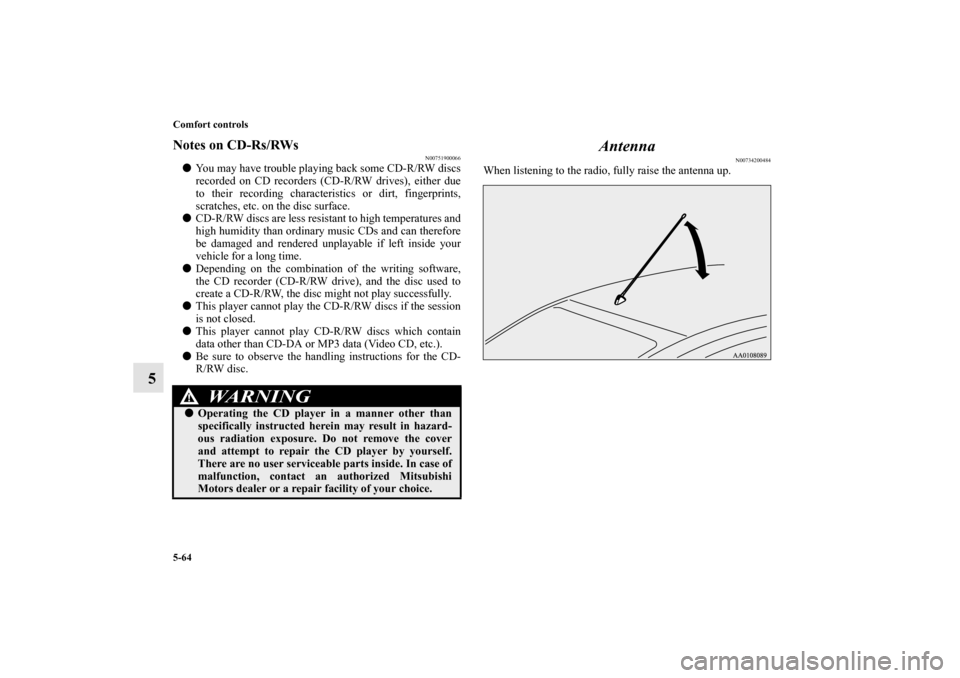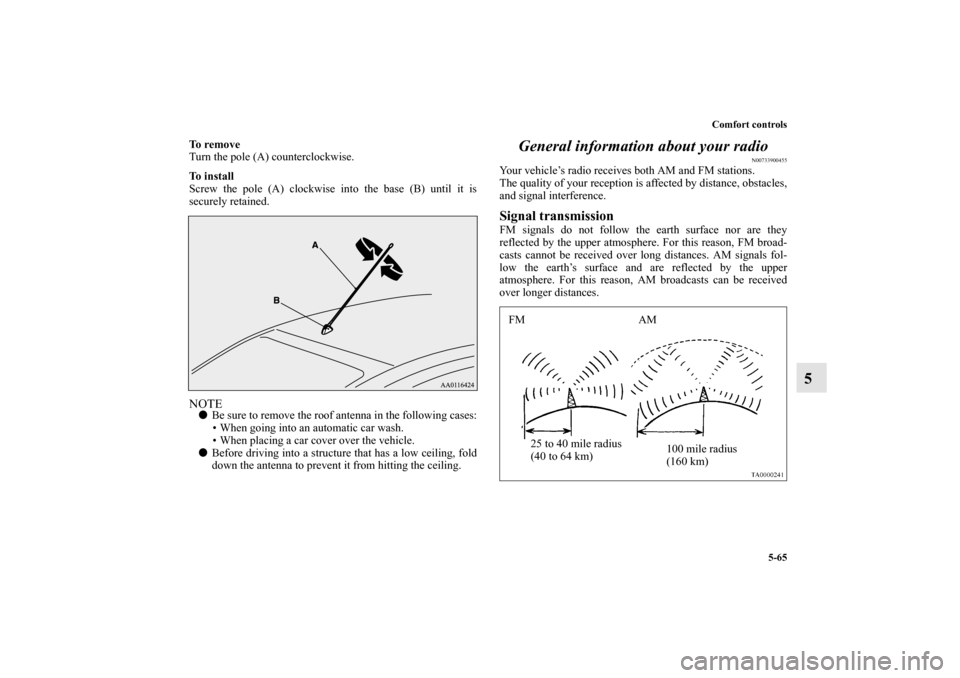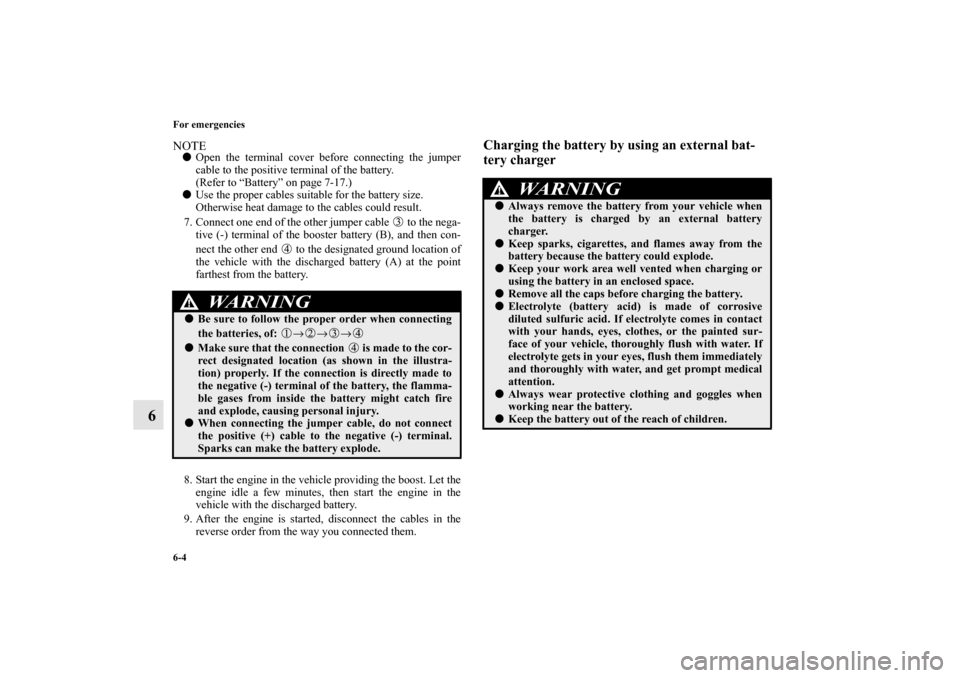Page 332 of 460

5-60 Comfort controls
5Error codes
N00736100780
If an error code appears in the display, take action in accordance with the table below.Audio system
iPod
(if so equipped)Error display
Item
Repair
CHECK DISCDisc is not loaded correctly, or condensation
on disc.Insert disc with label facing up.
Remove moisture from disc.
DISC ERRORDisc is dirty, scratched, or deformed; or exces-
sive vehicle vibration.Clean or replace disc. Retry when vibrations stop.
INTERNAL ELoading or eject error. Pick-up is out of posi-
tion.Eject disc and reload. If disc will not eject, bring your
vehicle to your authorized Mitsubishi Motors dealer or a
repair facility of your choice for repair.
HEAT ERROR Internal protection against high temperatures. Allow radio to cool by waiting about 30 minutes.
ERROR DC Foreign material is inside of radio or amplifier.Bring your vehicle to your authorized Mitsubishi Motors
dealer or a repair facility of your choice for repair.
Error display
Item
Repair
NO SONG There are no playable music files. Record music files in the iPod.
VER ERROR The iPod or its software cannot be recognized. Connect a supported iPod.BK0162600US.book 60 ページ 2013年3月22日 金曜日 午後2時41分
Page 333 of 460
Comfort controls
5-61
5
USB memory device
(if so equipped)
Error display
Item
Repair
FILE ERROR The file cannot be played. The file is protected by copyrights, etc. An error is dis-
played for several seconds, and then the next playable file
is played automatically.
UNSUPPORTED (first) →
DEVICE (after)The USB memory device cannot be recog-
nized. Remove the USB memory device.
UNSUPPORTED (first) →
FORMAT (after)The USB memory device format cannot be
recognized. Remove the USB memory device.
USB BUS PWRAn overcurrent or other power-supply error
has occurred.Remove the USB memory device.
Have the vehicle inspected at an authorized Mitsubishi
Motors dealer or a repair facility of your choice.
LSI ERROR Internal device errors Have the vehicle inspected at an authorized Mitsubishi
Motors dealer or a repair facility of your choice.
BK0162600US.book 61 ページ 2013年3月22日 金曜日 午後2時41分
Page 336 of 460

5-64 Comfort controls
5
Notes on CD-Rs/RWs
N00751900066
�You may have trouble playing back some CD-R/RW discs
recorded on CD recorders (CD-R/RW drives), either due
to their recording characteristics or dirt, fingerprints,
scratches, etc. on the disc surface.
�CD-R/RW discs are less resistant to high temperatures and
high humidity than ordinary music CDs and can therefore
be damaged and rendered unplayable if left inside your
vehicle for a long time.
�Depending on the combination of the writing software,
the CD recorder (CD-R/RW drive), and the disc used to
create a CD-R/RW, the disc might not play successfully.
�This player cannot play the CD-R/RW discs if the session
is not closed.
�This player cannot play CD-R/RW discs which contain
data other than CD-DA or MP3 data (Video CD, etc.).
�Be sure to observe the handling instructions for the CD-
R/RW disc.
Antenna
N00734200484
When listening to the radio, fully raise the antenna up.
WA R N I N G
!�Operating the CD player in a manner other than
specifically instructed herein may result in hazard-
ous radiation exposure. Do not remove the cover
and attempt to repair the CD player by yourself.
There are no user serviceable parts inside. In case of
malfunction, contact an authorized Mitsubishi
Motors dealer or a repair facility of your choice.
BK0162600US.book 64 ページ 2013年3月22日 金曜日 午後2時41分
Page 337 of 460

Comfort controls
5-65
5
To remove
Turn the pole (A) counterclockwise.
To i n s t a l l
Screw the pole (A) clockwise into the base (B) until it is
securely retained.NOTE�Be sure to remove the roof antenna in the following cases:
• When going into an automatic car wash.
• When placing a car cover over the vehicle.
�Before driving into a structure that has a low ceiling, fold
down the antenna to prevent it from hitting the ceiling.
General information about your radio
N00733900455
Your vehicle’s radio receives both AM and FM stations.
The quality of your reception is affected by distance, obstacles,
and signal interference.Signal transmissionFM signals do not follow the earth surface nor are they
reflected by the upper atmosphere. For this reason, FM broad-
casts cannot be received over long distances. AM signals fol-
low the earth’s surface and are reflected by the upper
atmosphere. For this reason, AM broadcasts can be received
over longer distances.FM AM
25 to 40 mile radius
(40 to 64 km)100 mile radius
(160 km)
BK0162600US.book 65 ページ 2013年3月22日 金曜日 午後2時41分
Page 344 of 460

6-4 For emergencies
6
NOTE�Open the terminal cover before connecting the jumper
cable to the positive terminal of the battery.
(Refer to “Battery” on page 7-17.)
�Use the proper cables suitable for the battery size.
Otherwise heat damage to the cables could result.
7. Connect one end of the other jumper cable to the nega-
tive (-) terminal of the booster battery (B), and then con-
nect the other end to the designated ground location of
the vehicle with the discharged battery (A) at the point
farthest from the battery.
8. Start the engine in the vehicle providing the boost. Let the
engine idle a few minutes, then start the engine in the
vehicle with the discharged battery.
9. After the engine is started, disconnect the cables in the
reverse order from the way you connected them.
Charging the battery by using an external bat-
tery charger
WA R N I N G
!�Be sure to follow the proper order when connecting
the batteries, of: →→→�Make sure that the connection is made to the cor-
rect designated location (as shown in the illustra-
tion) properly. If the connection is directly made to
the negative (-) terminal of the battery, the flamma-
ble gases from inside the battery might catch fire
and explode, causing personal injury.�When connecting the jumper cable, do not connect
the positive (+) cable to the negative (-) terminal.
Sparks can make the battery explode.
WA R N I N G
!�Always remove the battery from your vehicle when
the battery is charged by an external battery
charger.�Keep sparks, cigarettes, and flames away from the
battery because the battery could explode.�Keep your work area well vented when charging or
using the battery in an enclosed space.�Remove all the caps before charging the battery.�Electrolyte (battery acid) is made of corrosive
diluted sulfuric acid. If electrolyte comes in contact
with your hands, eyes, clothes, or the painted sur-
face of your vehicle, thoroughly flush with water. If
electrolyte gets in your eyes, flush them immediately
and thoroughly with water, and get prompt medical
attention.�Always wear protective clothing and goggles when
working near the battery.�Keep the battery out of the reach of children.
BK0162600US.book 4 ページ 2013年3月22日 金曜日 午後2時41分
Page 346 of 460

6-6 For emergencies
6
5. If you do not see steam or spray coming from under the
hood, leave the engine on until the high coolant tempera-
ture warning light goes off. After the high coolant temper-
ature warning light has gone off, you can start driving
again. If the high coolant temperature warning light stays
on, turn off the engine.
6. When you do not see any more steam or spray, open the
hood. Look for obvious leaks, such as a split radiator
hose. Be careful as components will be hot. Any leak
source must be repaired.
7. If there is no obvious leak source, check the coolant level
in the engine coolant reserve tank. If there is none, or if it
is too low, slowly add coolant.8. If the engine coolant reserve tank needs coolant, you will
probably also need to add coolant to the radiator. Do not
loosen or remove the radiator cap until the engine has
cooled down.
9. Start the engine, and slowly add coolant, up to the bottom
of the filler neck. Use plain water if you have to (and
replace it with the right coolant as soon as possible).
10. Replace the radiator cap and tighten it fully. Check the
coolant temperature warning light. You can start driving
again when the high coolant temperature warning light
does not come on.
11. Have the system inspected by your authorized Mitsubishi
Motors dealer or a repair facility of your choice.
WA R N I N G
!�Before raising the engine hood, check to see if there
is steam or spray coming from under the hood.
Steam or spray coming from an overheated engine
could seriously scald you.
Do not open the hood until there is no steam or
spray.
WA R N I N G
!�Removing the radiator cap could scald you with
escaping hot water or steam. When checking the
radiator level, cover the cap with a cloth before try-
ing to remove it. Turn it slowly counterclockwise,
without pressing down, to the first notch. The pres-
sure in the system will then be let out. When the
pressure is COMPLETELY LET OUT, press down
and keep turning the cap counterclockwise until it
comes off.
BK0162600US.book 6 ページ 2013年3月22日 金曜日 午後2時41分
Page 348 of 460

6-8 For emergencies
6
Jack
(if so equipped)
Before removing or storing the jack, move the driver’s seat
fully forward to access the jack from the rear seat area.
(Refer to “Front seat” on page 2-5.)
To r e m o v eTurn the shaft end of the jack in the direction (1) until the jack
fully retracts and remove the jack from the holder (A).To s t o r ePut the jack in the holder (A) and turn the shaft end of the jack
in the direction (2) by hand until the jack is firmly secured.
CAUTION
!�Never access, remove or store the jack from the
front of the driver’s seat. Doing so could damage
electrical wires under the driver’s seat.
WA R N I N G
!�After storing the jack in place, make sure the jack is
securely fixed in the holder.
If the jack is not fixed securely, it may move and hit
an occupant in an accident resulting in serious
injury or death. Also the jack may move forward
during driving and could interfere with driver’s
pedal operation causing an accident.
BK0162600US.book 8 ページ 2013年3月22日 金曜日 午後2時41分
Page 351 of 460

For emergencies
6-11
6
NOTE�Do not pull out an object, such as a nail or screw, that pen-
etrates the punctured tire.
�Move the vehicle so that the tire valve is positioned away
from the point where the tire touches the ground. If the
valve is near the point where the tire touches the ground,
the sealant may not enter the tire easily.
1. Park the vehicle on a safe, flat and level place.
2. Set the parking brake firmly.
3. On vehicles equipped with manual transaxle, stop the
engine and move the gearshift lever to the “R” (Reverse)
position.
On vehicles equipped with continuously variable trans-
mission (CVT), move the selector lever to the “P”
(PARK) position, and stop the engine.
4. Turn on the hazard warning flashers and set up a warning
sign, such as a warning triangle or flashing signal lamp, at
an adequate distance from the vehicle, and have all your
passengers leave the vehicle.
5. Take out the tire repair kit.
Make sure that the compressor switch is OFF.6. Shake the tire sealant bottle well.
NOTE�In cold conditions (when the ambient temperature is 32 °F
{0 °C} or lower), thickening of the tire sealant can make
the tire sealant hard to squeeze out of the bottle. Warm the
bottle between your hands inside the vehicle.
CAUTION
!�If the vehicle body is contaminated by the tire seal-
ant, wipe the tire sealant off immediately with a wet
cloth.�Immediately wash clothes contaminated with tire
sealant. The tire sealant may not be removed from
the clothes.
BK0162600US.book 11 ページ 2013年3月22日 金曜日 午後2時41分